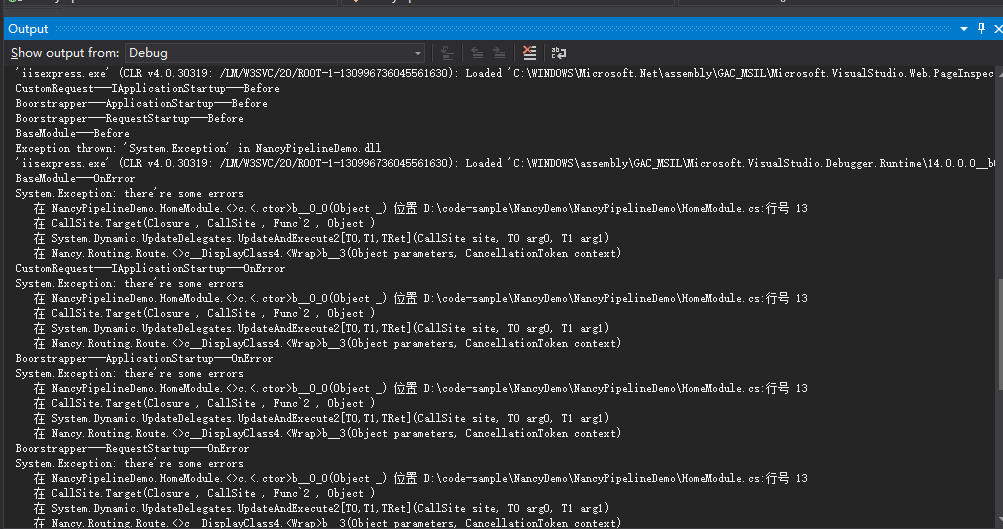Nancy之Pipelines三兄弟(Before After OnError)
一、简单描述
Before:如果返回null,拦截器将主动权转给路由;如果返回Response对象,则路由不起作用。
After : 没有返回值,可以在这里修改或替换当前的Response。
OnError : 返回值与Before相似,引发的错误或异常时的控制代码可以写在这里。
这三兄弟的大致作用,看名字,也可以这样简单的理解:
Before:处理之前要干的事。(返回null,继续处理;返回Response对象,不再做要干的那件事,换做Response对象要干的事)
After : 处理之后要干的事。
OnError : 处理出错了要干的事。
这三兄弟在NancyModule中的定义如下
public AfterPipeline After { get; set; }
public BeforePipeline Before { get; set; }
public ErrorPipeline OnError { get; set; }
而这三个Pipeline分别继承了
AsyncNamedPipelineBase<TAsyncDelegate, TSyncDelegate>和NamedPipelineBase<TDelegate>
所以与他们有关的就主要包含在5个类中!具体的放在最后来看一下!
二、简单用法
我们可以在Module中直接使用Before/After/OnError这三个
也可以在Bootstrapper中重写RequestStartup或者ApplicationStartup来实现
当然也可以自定义,只要实现IRequestStartup或者IApplicationStartup接口也可以完成相应的工作
下面我们就分别来说明一下
用法一:直接在Module中使用
定义一个BaseModule,具体如下:
public class BaseModule : NancyModule
{
public BaseModule()
{
//写法一
Before += ctx => {
System.Diagnostics.Debug.WriteLine("BaseModule---Before");
return null;
};
After += ctx => {
System.Diagnostics.Debug.WriteLine("BaseModule---After");
};
OnError += (ctx, ex) => {
System.Diagnostics.Debug.WriteLine("BaseModule---OnError");
System.Diagnostics.Debug.WriteLine(ex.ToString());
return null;
};
//写法二
//Before += MyBefore;
//After += MyAfter;
//OnError += MyOnError;
}
private Response MyBefore(NancyContext ctx)
{
System.Diagnostics.Debug.WriteLine("BaseModule---Before----写法二");
return null;
}
private void MyAfter(NancyContext ctx)
{
System.Diagnostics.Debug.WriteLine("BaseModule---After----写法二");
}
private Response MyOnError(NancyContext ctx, Exception ex)
{
System.Diagnostics.Debug.WriteLine("BaseModule---OnError----写法二");
System.Diagnostics.Debug.WriteLine(ex.ToString());
return null;
}
}
在BaseModule中,用了两种不同的形式来对Before、After、OnError进行处理,
都只是打印出一些简单的信息,看这些输出的信息,可以帮助理解内部执行的顺序!
可以看到,Before和OnError是Response类型的,After是void类型的
在这三兄弟的具体处理中,要根据实际情况来定(当然,你想就打印出一些东西也没问题,毕竟我们还是可以把这些东西写进日记嘛)!
下面定义一个HomeModule,具体如下:
public class HomeModule : BaseModule
{
public HomeModule()
{
Get["/"] = _ => "Catcher Wong";
Get["/err"] = _ => { throw new Exception("there're some errors"); };
}
}
其中,当我们访问http://localhost:port时,会显示我们的文字,访问http://localhost:port/err时,会抛出我们设定异常!
运行起来,看看我们的Output(输出)窗口

访问http://localhost:port/err时的情况

出现异常后并没有去执行After!!执行完OnError之后就结束了。
同样的,用写法二也是如此!

基本一致的效果。
用法二:在bootstrapper中重写RequestStartup或者ApplicationStartup
先来看看重写RequestStartup
public class Bootstrapper : DefaultNancyBootstrapper
{
protected override void RequestStartup(TinyIoCContainer container, IPipelines pipelines, NancyContext context)
{
base.RequestStartup(container, pipelines, context);
pipelines.BeforeRequest += ctx => {
System.Diagnostics.Debug.WriteLine("Boorstrapper---RequestStartup---Before");
return null;
};
pipelines.AfterRequest += ctx => {
System.Diagnostics.Debug.WriteLine("Boorstrapper---RequestStartup---After");
};
pipelines.OnError += (ctx,ex) => {
System.Diagnostics.Debug.WriteLine("Boorstrapper---RequestStartup---OnError");
System.Diagnostics.Debug.WriteLine(ex.ToString());
return null;
};
}
}
我们同样是输出相应的信息,运行前,把我们BaseModule中“三兄弟”的注释掉

再来看看重写ApplicationStartup
public class Bootstrapper : DefaultNancyBootstrapper
{
protected override void ApplicationStartup(TinyIoCContainer container, IPipelines pipelines)
{
base.ApplicationStartup(container, pipelines);
pipelines.BeforeRequest += MyBeforeRequest;
pipelines.AfterRequest += MyAfterRequest;
pipelines.OnError += MyOnErroe;
}
private Response MyBeforeRequest(NancyContext ctx)
{
System.Diagnostics.Debug.WriteLine("Boorstrapper---ApplicationStartup---Before");
return null;
}
private void MyAfterRequest(NancyContext ctx)
{
System.Diagnostics.Debug.WriteLine("Boorstrapper---ApplicationStartup---After");
}
private Response MyOnErroe(NancyContext ctx, Exception ex)
{
System.Diagnostics.Debug.WriteLine("Boorstrapper---ApplicationStartup---OnError");
System.Diagnostics.Debug.WriteLine(ex.ToString());
return null;
}
}
我们同样是输出相应的信息,运行前,把我们BaseModule和RequestStartup中“三兄弟”的注释掉

用法三:自定义用法(Nancy中有很多东西可以自定义,这个很灵活,很nice!)
下面来看看自定就要怎么使用!
public class CustomRequest : IApplicationStartup
{
public void Initialize(IPipelines pipelines)
{
pipelines.BeforeRequest.AddItemToEndOfPipeline(ctx =>
{
System.Diagnostics.Debug.WriteLine("CustomRequest---IApplicationStartup---Before");
return null;
});
pipelines.AfterRequest.AddItemToEndOfPipeline(ctx =>
{
System.Diagnostics.Debug.WriteLine("CustomRequest---IApplicationStartup---After");
});
pipelines.OnError.AddItemToEndOfPipeline((ctx, ex) =>
{
System.Diagnostics.Debug.WriteLine("CustomRequest---IApplicationStartup---OnError");
System.Diagnostics.Debug.WriteLine(ex.ToString());
return null;
});
}
}
我们自定义一个CustomRequest让它实现IApplicationStartup接口即可!
剩下的就是实现Before、After、OnError的处理!!
把之前的相关处理注释掉,运行。
效果如下:


现在是否很清晰呢?
Before 的执行顺序 IApplicationStartup > ApplicationStartup > RequestStartup > BaseModule

与OnError的处理顺序一样!!
三、内部实现的简单分析
前面也提到了,这三兄弟的实现主要有这几个类
BeforePipeline、AfterPipeline、ErrorPipeline以及抽象类NamedPipelineBase、AsyncNamedPipelineBase
NancyModule中也有相应的Before、After、OnError定义!
先来看看BeforePipeline吧
BeforePipeline是实现了AsyncNamedPipelineBase这个抽象类
里面有用到 implicit operator ,不熟悉的可以参考
有一个重写的Wrap方法,用于把同步的包装成异步的形式
protected override PipelineItem<Func<NancyContext, CancellationToken, Task<Response>>> Wrap(PipelineItem<Func<NancyContext, Response>> pipelineItem)
{
var syncDelegate = pipelineItem.Delegate;
Func<NancyContext, CancellationToken, Task<Response>> asyncDelegate = (ctx, ct) =>
{
var tcs = new TaskCompletionSource<Response>();
try
{
var result = syncDelegate.Invoke(ctx);
tcs.SetResult(result);
}
catch (Exception e)
{
tcs.SetException(e);
}
return tcs.Task;
};
return new PipelineItem<Func<NancyContext, CancellationToken, Task<Response>>>(pipelineItem.Name, asyncDelegate);
}
其他的大致都可以总结成下面这句代码:
pipeline.AddItemToEndOfPipeline(xxxx);
把xxxx添加到管道中的末尾去。
同样的,AfterPipeline与ErrorPipeline也是相类似的,
不同的是ErrorPipeline实现的是NamedPipelineBase这个抽象类,
没有那个Wrap方法,多了一个dynamic的Invoke方法
public dynamic Invoke(NancyContext context, Exception ex)
{
dynamic returnValue = null;
using (var enumerator = this.PipelineDelegates.GetEnumerator())
{
while (returnValue == null && enumerator.MoveNext())
{
returnValue = enumerator.Current.Invoke(context, ex);
}
}
return returnValue;
}
这个Invoke方法的作用是:依次调用每个管道项目,直到有管道项目被返回或者所有管道项目都已经被调用了!
两个NamePipelineBase(同步和异步)都定义了一个pipelineItems(要执行的管道项目集合)
还有众多虚方法!!大部分是插入的,还有一个删除的。
其中插入可分为在Pipeline的开始和结尾插入,以及是否要替换已存在的同名的Pipeline
下面的是比较重要的一个方法InsertItemAtPipelineIndex
同步的
public virtual void InsertItemAtPipelineIndex(int index, PipelineItem<TDelegate> item, bool replaceInPlace = false)
{
var existingIndex = this.RemoveByName(item.Name);
var newIndex = (replaceInPlace && existingIndex != -) ? existingIndex : index;
this.pipelineItems.Insert(newIndex, item);
}
异步的
public virtual void InsertItemAtPipelineIndex(int index, PipelineItem<TAsyncDelegate> item, bool replaceInPlace = false)
{
var existingIndex = this.RemoveByName(item.Name);
var newIndex = (replaceInPlace && existingIndex != -) ? existingIndex : index;
this.pipelineItems.Insert(newIndex, item);
}
最后来看看我们在Bootstrapper和自定义用到的IPipelines
public interface IPipelines
{
BeforePipeline BeforeRequest { get; set; }
AfterPipeline AfterRequest { get; set; }
ErrorPipeline OnError { get; set; }
}
十分简单的定义!
Nancy之Pipelines三兄弟(Before After OnError)的更多相关文章
- 好用的排名函数~ROW_NUMBER(),RANK(),DENSE_RANK() 三兄弟
排名函数三兄弟,一看名字就知道,都是为了排名而生!但是各自有各自的特色!以下一个例子说明问题!(以下栗子没有使用Partition By 的关键字,整个结果集进行排序) RANK 每个值一个排名,同样 ...
- sql语句中----删除表数据的"三兄弟"
说到删除表数据的关键字,大家记得最多的可能就是delete了 然而我们做数据库开发,读取数据库数据.对另外的两兄弟用得就比较少了 现在来介绍另外两个兄弟,都是删除表数据的,其实也是很容易理解的 老大- ...
- Promise的三兄弟:all(), race()以及allSettled()
摘要: 玩转Promise. 原文:Promise 中的三兄弟 .all(), .race(), .allSettled() 译者:前端小智 Fundebug经授权转载,版权归原作者所有. 从ES6 ...
- 一网打尽 @ExceptionHandler、HandlerExceptionResolver、@controlleradvice 三兄弟!
把 @ExceptionHandler.HandlerExceptionResolver.@controlleradvice 三兄弟放在一起来写更有比较性.这三个东西都是用来处理异常的,但是它们使用的 ...
- 设计模式系列之工厂模式三兄弟(Factory Pattern)
说明:设计模式系列文章是读刘伟所著<设计模式的艺术之道(软件开发人员内功修炼之道)>一书的阅读笔记.个人感觉这本书讲的不错,有兴趣推荐读一读.详细内容也可以看看此书作者的博客https:/ ...
- Mysql 中写操作时保驾护航的三兄弟!
这期的文章主要是讲述写操作过程中涉及到的三个日志文件,看过前几期的话可能你或多或少已经有些了解了(或者从别的地方也了解过).比如整个写操作过程中用到的两阶段提交,又或者是操作过程中涉及到的日志文件,但 ...
- 站长管理服务器必读:Ftp、Ftps与Sftp三兄弟的不同与区别以及部署全指引
文章标题: 站长管理服务器必读:Ftp.Ftps与Sftp三兄弟的不同与区别以及部署全指引 关键字 : ftp,sftp,freesshd,ftps 文章分类: 教程 创建时间: 2020年3月23日 ...
- Nancy总结(三)Nancy资料介绍
Nancy 是一个轻量级用于构建基于 HTTP 的 Web 服务,可以基于 .NET 和 Mono 平台构建轻量级基于 HTTP 的Web 服务.它更多的是借鉴了Ruby的一些特性和Ruby的MVC ...
- .NET Nancy 详解(三) Respone 和 ViewEngine
我们在ASP.NET MVC中可以返回各种类型的ActionResult(以下图片来自于园友--待补..) 在Nancy 中本着简单粗暴的原则,使用方式略有不同.这期我们使用的版本是Nancy的第一个 ...
随机推荐
- TaintDroid深入剖析之启动篇
1 背景知识 1.1 Android平台软件动态分析现状 众所周知,在计算机领域中所有的软件分析方法都可以归为静态分析和动态分析两大类,在Android平台也不例外.而随着软件加固.混淆技术的不 ...
- 对改善ABP的一些建议
园子里有不少同学对ABP框架很感兴趣,而且也已经将ABP用在了商用项目中,有些可能还在操练阶段.一般来说,我们使用ABP默认的一些功能已经足够了,但还是有很多人想要自己拓展一些功能而自己实现不了或者说 ...
- 【腾讯Bugly干货分享】美团大众点评 Hybrid 化建设
本文来自于腾讯Bugly公众号(weixinBugly),未经作者同意,请勿转载,原文地址:http://mp.weixin.qq.com/s/rNGD6SotKoO8frmxIU8-xw 本期 T ...
- 迷你MVVM框架 avalonjs 实现上的几个难点
经过两个星期的性能优化,avalon终于实现在一个页面绑定达到上万个的时候不卡顿的目标(angular的限制是2000).现在稍作休息,总结一下avalon遇到的一些难题. 首先是如何监控的问题.所有 ...
- Hibernate 延迟加载原理
如何简单的理解延迟加载?开发中常见的org.hibernate.LazyInitializationException no session错误又是怎么产生的?下面通过一个简单的例子来解析一下 ...
- 一次 Oracle 算出运算溢出问题 排查解决 (并非除数为零!)
前段时间 出现过这个问题,: 表中有一列为number类型 rec_recordlength (两个时间的间隔长度/秒) 部分数据 统计这个字段就会出现 "算出运算溢出" 错误,很 ...
- Java集合类的组织结构和继承、实现关系
Collection继承.实现关系如下(说明(I)表示接口,(C)表示Java类,<--表示继承,<<--表示实现): (I)Iterable |<--(I)Collectio ...
- SQL Server 错误日志过滤(ERRORLOG)
一.背景 有一天我发现SQL Server服务器的错误日志中包括非常多关于sa用户的登陆错误信息:“Login failed for user 'sa'. 原因: 评估密码时出错.[客户端: XX.X ...
- SQL Server 跨网段(跨机房)FTP复制
一.本文所涉及的内容(Contents) 本文所涉及的内容(Contents) 背景(Contexts) 搭建过程(Process) 注意事项(Attention) 参考文献(References) ...
- 利用typescript使backbone强类型智能提示
模型类一旦多了没有强类型和智能提示是相当痛苦的,所以. 仅仅用ts定义一个模型类: class Person extends Backbone.Model { defaults = { Name:&q ...
